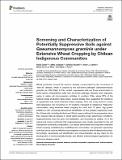Por favor, use este identificador para citar o enlazar a este item:
http://hdl.handle.net/10261/167520COMPARTIR / EXPORTAR:
 SHARE SHARE
 CORE
BASE CORE
BASE
|
|
| Visualizar otros formatos: MARC | Dublin Core | RDF | ORE | MODS | METS | DIDL | DATACITE | |

| Título: | Screening and Characterization of Potentially Suppressive Soils against Gaeumannomyces graminis under Extensive Wheat Cropping by Chilean Indigenous Communities |
Autor: | Durán, Paola; Jorquera, Milko; Viscardi, Sharon; Carrión, Víctor J.; Mora, María de la Luz; Pozo Jiménez, María José | Palabras clave: | Gaeumannomyces graminis Mapuche Microbial communities Suppressive soils Triticum aestivum Take-all disease Biocontrol |
Fecha de publicación: | 15-ago-2017 | Editor: | Frontiers Media | Citación: | Frontiers in Microbiology 8: 1552 (2017) | Resumen: | Wheat production around the world is severely compromised by the occurrence of “take-all” disease, which is caused by the soil-borne pathogen Gaeumannomyces graminis var. tritici (Ggt). In this context, suppressive soils are those environments in which plants comparatively suffer less soil-borne pathogen diseases than expected, owing to native soil microorganism activities. In southern Chile, where 85% of the national cereal production takes place, several studies have suggested the existence of suppressive soils under extensive wheat cropping. Thus, this study aimed to screen Ggt-suppressive soil occurrence in 16 locations managed by indigenous “Mapuche” communities, using extensive wheat cropping for more than 10 years. Ggt growth inhibition in vitro screenings allowed the identification of nine putative suppressive soils. Six of these soils, including Andisols and Ultisols, were confirmed to be suppressive, since they reduced take-all disease in wheat plants growing under greenhouse conditions. Suppressiveness was lost upon soil sterilization, and recovered by adding 1% of the natural soil, hence confirming that suppressiveness was closely associated to the soil microbiome community composition. Our results demonstrate that long-term extensive wheat cropping, established by small Mapuche communities, can generate suppressive soils that can be used as effective microorganism sources for take-all disease biocontrol. Accordingly, suppressive soil identification and characterization are key steps for the development of environmentally-friendly and efficient biotechnological applications for soil-borne disease control. | Versión del editor: | https://doi.org/10.3389/fmicb.2017.01552 | URI: | http://hdl.handle.net/10261/167520 | DOI: | 10.3389/fmicb.2017.01552 | ISSN: | 1664-302X | E-ISSN: | 1664-302X |
| Aparece en las colecciones: | (EEZ) Artículos |
Ficheros en este ítem:
| Fichero | Descripción | Tamaño | Formato | |
|---|---|---|---|---|
| gaeumannomyces_graminis_Duran.pdf | 4,1 MB | Adobe PDF |  Visualizar/Abrir |
CORE Recommender
PubMed Central
Citations
16
checked on 20-abr-2024
SCOPUSTM
Citations
31
checked on 19-abr-2024
WEB OF SCIENCETM
Citations
26
checked on 23-feb-2024
Page view(s)
282
checked on 24-abr-2024
Download(s)
213
checked on 24-abr-2024

